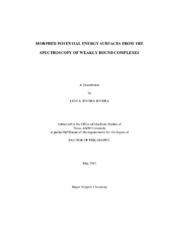| dc.description.abstract | In this research the so-called potential morphing method was used to generate reliable interaction potential energy surfaces for weakly bound complexes. The potential morphing method is based on the optimization of modified computed ab initio potential energy surfaces to give predicted spectroscopic data, in agreement with the experimental values. In the standard potential morphing procedure the computed ab initio potential is adjusted by scaling, shifting, and dilating transformations to reproduce the experimental data.
In this research, selected systems have been chosen to be studied based on the availability of varied and accurate sets of experimental data. In the present work, accurate interaction potential energy surfaces are obtained for the weakly bound complexes: Ne:HCl, OC:HX (X = F, Cl, Br, I) and HI:CO2. A comprehensive study on the interaction potential of these systems provides fundamental perspectives on the influence of different intermolecular forces. In addition the ground state isotopic isomerization observed in the OC:HI system may suggest a possible structural change of proteins, and other biological macromolecules, in deuterated solvents.
In this dissertation, an alternative approach to morphing the potential energy surfaces of non-covalent interactions is also presented. In this approach the morphed potential is generated as a linear combination of ab initio potentials, that are computed at different levels of theory. This new morphing approach is applied to OC:HCl and is found to be of similar accuracy to that of the previous morphing method. In addition, this new method is also extended from four-dimensions to six-dimensions and is applied to the OC:HF system to obtain a vibrationally-complete six-dimensional morphed potential. | en |


